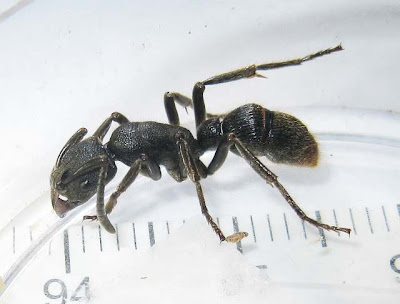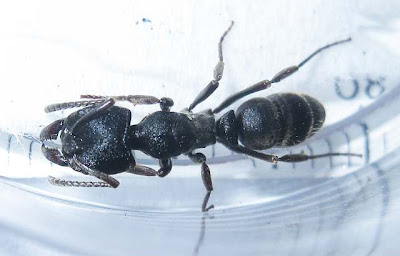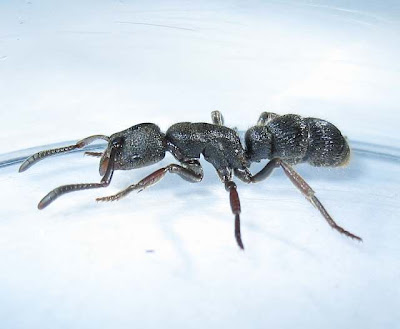Odontotermes longignathus soldiers and workers.
The soldier of Odontotermes longignathus here showing the length of this termite.
An Odontotermes longignathus soldier.
Profile view of Odontotermes longignathus soldier.
Front view of Odontotermes longignathus soldier.
The workers of Odontotermes longignathus.
Typical of Odontotermes the workers of Odontermes longignathus are monomorphic.
Close up of an Odontotermes longignathus worker.
See also other species of this genus:
See also:
Taxonomy
No rank: cellular organisms
Superkingdom (Domain): Eukaryota
No rank: Opisthokonta
Kingdom: Metazoa
No rank: Eumetazoa
No rank (Subkingdom): Bilateria
No rank (Branch): Protostomia
No rank (Infrakingdom): Ecdysozoa
No rank (Superphylum): Panarthropoda
Phylum: Arthropoda
No rank (Subphylum): Mandibulata
No rank: Pancrustacea
Subphylum (Epiclass): Hexapoda
Class: Insecta
No rank (Subclass): Dicondylia
Subclass (Infraclass): Pterygota
Infraclass: Neoptera
No rank: Polyneoptera
No rank (Superorder): Dictyoptera
Order: Blattodea
Superfamily: Blattoidea
No rank: Termitoidae 1912919
Family: Termitidae 46569
Subfamily: Macrotermitinae 62955
Genus: Odontotermes 60587
Species List:
001. adampurensis
002. agilis
003. akengeensis
004. amanicus
005. anamallensis
006. anceps
007. angustatus
008. angustignathus
009. angustipennis
010. annulicornis
011. apollo
012. aquaticus
013. assmuthi
014. aurora
015. badius
016. bellahunisensis
017. bequaerti
018. bhagwatii
019. billitoni
020. boetonensis
021. bomaensis
022. boranicus
023. borgoriensis
024. bottegoanus
025. boveni
026. brunneus
027. buchholzi
028. butteli
029. caffrariae
030. capensis
031. celebensis
032. ceylonicus
033. classicus
034. conignathus
035. culturarum
036. denticulatus
037. diana
038. dimorphus
039. distans
040. dives
041. djampeensis
042. domesticus
043. ebeni
044. egregius
045. elgonensis
046. erodens
047. escherichi
048. fallax
049. feae
050. feaeoides
051. fidens
052. flammifrons
053. fockianus
054. fontanellus
055. formosanus
056. foveafrons
057. fulleri
058. fuyangensis
059. ganpati
060. garambae
061. giriensis
062. globicola
063. grandiceps
064. grassei
065. gravelyi
066. guptai
067. gurdaspurensis
068. hageni
069. hainanensis
070. holmgreni
071. horai
072. horni
073. incisus
074. indicus
075. indrapurensis
076. interveniens
077. iratus
078. javanicus
079. kapuri
080. karawajevi
081. karnyi
082. kibarensis
083. koenigi
084. kulkarnii
085. lacustris
086. latericius
087. latialatus
088. latigula
089. latiguloides
090. latissimus
091. lautus
092. lobintactus
093. longignathus
094. longigula
095. longzhouensis
096. luoyangensis
097. maesodensis
098. magadalenae
099. makassarensis
100. malaccensis
101. maladictus
102. malelaensis
103. maliki
104. mathuri
105. maximus
106. mediocris
107. meridionalis
108. microdentatus
109. microps
110. minutus
111. mirganjensis
112. mohandi
113. monodon
114. montanus
115. mukimbunginis
116. neodenticulatus
117. nilensis
118. nolaensis
119. obesus
120. oblongatus
121. okahandjae
122. ostentans
123. palmquisti
124. paradenticulatus
125. paralatigula
126. parallelus
127. paraoblongatus
128. parvidens
129. patruus
130. pauperans
131. peshawarensis
132. planiceps
133. praevalens
134. preliminaris
135. pretoriensis
136. prodives
137. profeae
138. proformosanus
139. prolatigula
140. proximus
141. pujiangensis
142. pyriceps
143. qianyangensis
144. ramulosus
145. rectanguloides
146. redemanni
147. rehobothensis
148. robustus
149. rothschildianus
150. salebrifrons
151. sarawakensis
152. schmitzi
153. scrutor
154. sellathorax
155. shanglinensis
156. sikkimensis
157. silamensis
158. silvaticus
159. silvestrii
160. silvicolus
161. simalurensis
162. simplicidens
163. sinabangensis
164. singsiti
165. sjostedti
166. smeathmani
167. snyderi
168. somaliensis
169. stanleyvillensis
170. stercorivorus
171. sudanensis
172. sundaicus
173. takensis
174. tanganicus
175. taprobanes
176. terricola
177. tragardhi
178. transvaalensis
179. vaishno
180. vulgaris
181. wallonensis
182. wuzhishanensis
183. yadevi
184. yaoi
185. yarangensis
186. yunnanensis
187. zambesiensis
188. zulunatalensis
189. zunyiensis
Last Updated: 2012 05 18
© 2011 - 2012 Quah. All rights reserved.






































